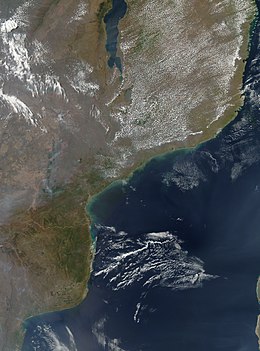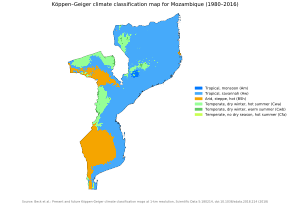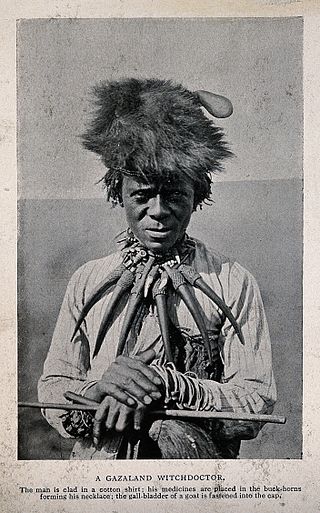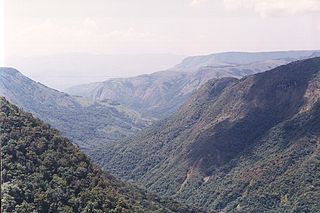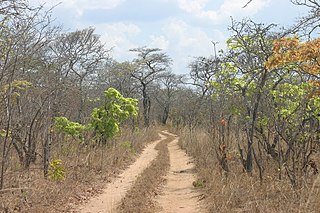Physical features
The Coast
The coastline extends from 26° 52′ S. to 10° 40′ S., and from south to north makes a double curve with a general trend outward to the east. It has a length of 2,300 kilometres (1,430 mi).
The southern coastline is characterized by sandy beaches backed by coastal dunes. The dunes can reach up to 120 m (390 ft) in height, and older dunes are vegetated. Behind the coastal dunes are lagoons, including river estuaries, closed saline lagoons, and salt lakes. [2] Some 65 km (40 mi) north of the South African frontier is the deep indentation of Maputo Bay (formerly Delagoa Bay). The land then turns outward to Cape Correntes, a little north of which is Inhambane Bay. Bending westward again and passing the Bazaruto Archipelago of several small islands, of which the chief is Bazaruto.
Mozambique's central coast, from Bazaruto Island north to Angoche Island, is known as the Bight of Sofala or Sofala Bay. It is also known as the Swamp Coast, and is characterized by extensive mangrove swamps and coastal wetlands. As in the south, the coastline is generally low, and harbours are few and poor. Beira is the principal seaport on the central coast, with rail and highway links to the interior.
The bay has an area of 801,590 km2 (309,500 sq mi). The continental shelf is up to 140 km (87 mi) wide at Beira, and is Mozambique's most important marine fishery. Several large rivers, including the Save, Pungwe, and Zambezi, create coastal estuaries and river deltas, of which the Zambezi delta is the largest. [3] North of the Zambezi, the small coralline islands of the Primeiras and Segundas Archipelago lie parallel to the coast.
The northern coast is much indented, abounding in rocky headlands and rugged cliffs, with an almost continuous fringe of islands. On one of these islands is Mozambique, and immediately north of that port is Conducia Bay. Somewhat farther north are two large bays, Fernao Veloso Bay and Memba Bay. Nacala on Fernao Veloso Bay is the principal seaport on the northern coast, with a rail link to Malawi and the coalfields of northwestern Mozambique. North of Fernao Veloso and Memba bays is Pemba Bay, where there is commodious anchorage for heavy draught vessels. North of Pemba Bay the Quirimbas Islands lie offshore, and numerous bays and estuaries indent the coast. Cape Delgado, the northernmost point on Mozambique's coast, is part of the delta of the Ruvuma River, which forms Mozambique's border with Tanzania.
The northern coast is part of the East African coral coast, a marine ecoregion that extends along the coasts of northern Mozambique, Tanzania, and Kenya. [4] Along the northern coast the Mozambique Current, which flows south between Madagascar and the continent is close to the coast and scours out all the softer material, while at the same time the corals are building in deep waters.
A recent global remote sensing analysis suggested that there were 2,029km² of tidal flats in Mozambique, making it the 16th ranked country in terms of how much tidal flat occurs there. [5]
Orography
Orographically the backbone of the country is the mountain chain which forms the eastern escarpment of the continental plateau. It does not present a uniformly abrupt descent to the plains, but in places, as in the lower Zambezi district, slopes gradually to the coast. The Lebombo Mountains, behind Delagoa Bay, nowhere exceed 630 m (2,070 ft) in height. The Manica Plateau, farther north between the Save and Zambezi rivers, is higher, rising towards the Eastern Highlands along the border with Zimbabwe. Monte Binga (2,440 m or 8,010 ft), on the border with Zimbabwe, is Mozambique's highest peak. Mount Gorongosa (2,000 m or 6,550 ft) lies north-east of the Manica Plateau, and is, like it, of granitic formation. Gorongosa, rising isolated with precipitous outer slopes, has been likened in its aspect to a frowning citadel. East of Gorongosa a graben valley extends from the Zambezi to Pungwe Bay, the southern extension of the African Rift Valley. The Cheringoma Plateau lies east of the graben, sloping gently towards the coast.
The chief mountain range lies north of the Zambezi, and east of Lake Chilwa, namely, the Namuli Mountains, in which Namuli Peak rises to 2,700 m (8,860 ft), and Molisani, Mruli and Mresi attain altitudes of 2,000 to 2,400 m (6,500 to 8,000 ft) These mountains are covered with magnificent forests. Farther north the river basins are divided by well-marked ranges with heights of 900 m (3,000 ft) and over. Near the south-east shore of Lake Malawi there is a high range (1,500 to 1,800 m or 5,000 to 6,000 ft) with an abrupt descent to the lake — some 900 m (3,000 ft) in 10 km (6 mi). The country between Malawi and Ibo is remarkable for the number of fantastically-shaped granite peaks, or inselbergs, which rise from the plateau.
The plateau lands west of the escarpment are of moderate elevation — perhaps averaging 600 to 750 m (2,000 to 2,500 ft). It is, however, only along the Zambezi and north of that river that Mozambique's territory reaches to the continental plateau. This northern plain has been categorised by the World Wildlife Fund as part of the Eastern miombo woodlands ecoregion.
Rivers
Besides the Zambezi, the most considerable river in Mozambique is the Limpopo which enters the Indian Ocean about 160 km (100 mi) north of Maputo Bay. The other Mozambican rivers with considerable drainage areas are the Komati, Save, Buzi, and Pungwe south of the Zambezi, and the Licungo (Likungo), Ligonha, Lúrio, Montepuez (Montepuesi or Mtepwesi), Messalo (or Msalu), and Ruvuma (or Rovuma) with its affluent the Lugenda (or Lujenda), north of the Zambezi.
The Save (or Sabi) rises in Zimbabwe at an elevation of over 900 m (3,000 ft), and after flowing south for over 320 km (200 mi) turns east and pierces the mountains some 270 km (170 mi) from the coast, being joined near the Zimbabwe-Mozambique frontier by the Lundi. Cataracts entirely prevent navigation above this point. Below the Lundi confluence the bed of the Save becomes considerably broader, varying from 1 to 3 km (1⁄2 to 2 mi). In the rainy season the Save is a large stream and even in the "dries" it can be navigated from its mouth by shallow draught steamers for over 240 km (150 mi). Its general direction through Mozambique is east by north. At its mouth it forms a delta 100 km (60 mi) in extent.
The Buzi (350 km or 220 mi) and Pungwe (290 km or 180 mi) are streams north of and similar in character to the Save. They both rise in the Manica Highlands and enter the ocean in a large estuary, their mouths 1.5 to 3 km (1 to 2 mi) apart. The lower reaches of both streams are navigable, the Buzi for 40 km (25 mi), the Pungwe for about 3 km (2 mi). The port of Beira is at the mouth of the Pungwe.
Of the north-Zambezi streams the Licungo, rising in the hills south-east of Lake Chilwa, flows south and enters the ocean not far north of Quelimane. The Lúrio, rising in the Namuli Mountains, flows north-east, having a course of some 320 km (200 mi). The Montepurez and the Messalo drain the country between the Lúrio and Ruvuma basins. Their banks are in general well-defined and the wet season rise seems fairly constant.
Somali Plate
Geologists have divided the Phanerozoic era of Mozambique's geology into the Karoo and post-Karoo era. This terminology is mostly used pertaining to studies of the structural and stratigraphic composition of rocks in the Zambezi valley. [6] Mozambique entirely lies within the Somali Plate. [7]
Facts
- Area
- Total: 801,590 km2 (309,500 sq mi)
- country rank in the world: 35th
- Land: 786,380 km²
- Water: 13,000 km²
- Area comparative
- Australia comparative: approximately the size of New South Wales
- Canada comparative: slightly less than twice the size of Newfoundland and Labrador
- United States comparative: slightly less than three times the size of Colorado
- EU comparative: slightly less than 3/5 larger than Spain
Capital
Major Cities
Other Cities
Land boundaries:total: 4,571 km
border countries: Malawi 1,569 km, South Africa 491 km, Eswatini 105 km, Tanzania 756 km, Zambia 419 km, Zimbabwe 1,231 km
Coastline: 2,470 km
Maritime claims:
territorial sea:12 nmi (22 km)
exclusive economic zone:578,986 km2 (223,548 sq mi) and 200 nmi (370 km)
Elevation extremes:
lowest point: Indian Ocean 0 m
highest point: Monte Binga 2 436 m
Natural resources: coal, titanium, natural gas, hydropower, tantalum, graphite
Land use:
arable land: 6.51% (2011), 5.43% (2005 est.), 3.98% (1998 est.)
permanent crops: 0.25% (2011), 0.29% (2005 est.), 0.29% (1998 est.)
other: 93.24% (2011), 94.28% (2005 est.), 95.73% (1998 est.)
Irrigated land:1,181 km2 (456 sq mi) (2003)
Total renewable water resources: 217.1 km3 (2011)
Natural hazards: severe droughts; devastating cyclones and floods occur in central and southern provinces
Environment — current issues: a long civil war and recurrent drought in the hinterlands have resulted in increased migration of the population to urban and coastal areas with adverse environmental consequences; desertification; pollution of surface and coastal waters; elephant poaching for ivory is a problem
Environment — international agreements:
party to: Biodiversity, Climate Change, Climate Change-Kyoto Protocol, Desertification, Endangered Species, Hazardous Wastes, Law of the Sea, Ozone Layer Protection, Ship Pollution, Wetlands
Ecoregions
